+1 (862) 222-0442 (EST)
Medusa’s Myth
Not the Monster you thought?
Dolphins in Ancient Art
A symbol of protection, love, and playfulness
by Maria Evangelatou
Medusa is one of the most recognizable characters of ancient Greek mythology, known as the deadly female monster with snaky hair who could turn men into stone just by looking at them. Eventually, she was killed by the hero Perseus, who offered her severed head to his divine helper, Athena. The goddess used it as a protective device, integrating it into her attire. That power of protection was called upon countless times, whenever Medusa’s frontal face with elegant serpentine locks was depicted as a talisman on any kind of surface, from jewelry and vessels to armor and buildings.

Medusa (center) is flanked by Perseus (left) who looks away while decapitating her, under the gaze of his divine helper Hermes (right). Black-figured olpe (jar) of around 550-530 BC. British Museum, London.

Athena in full fighting gear, with shield, spear, and helmet, wearing Medusa’s head (the Gorgoneion) on her aegis—a special protective device worn on her torso. 525 BC, Antikensammlung Berlin (Berlin Antiquities Collection).
Did the ancient Greeks believe that the world was safer thanks to the defeat of Medusa and the appropriation of her power? Or should we be asking a more critical question, such as, who created this narrative and why? A closer look at Medusa’s story through surviving texts and images across the centuries reveals a complex and fascinating cultural creation that can be better understood against the backdrop of the patriarchal values of the various societies involved in this narrative, from ancient Greece and Rome to Renaissance Italy and beyond.


Perseus decapitates a sleeping Medusa in front of his divine helper, Athena. Red-figured pelike (jar) around 450-440 BC (one of the earliest surviving images of Medusa that does not have monstrous features). Metropolitan Museum of Art, New York.
In the warrior culture of ancient Greece, Medusa was the creation of a male-dominated society. Men produced the majority of mythical texts and images, which consequently reflected and promoted male perspectives and concerns. Women were considered “by nature” inferior, weak, and unruly beings, destined to be tamed by men and learn to serve and obey them. If women ever dared to confront male authority and claim independence and power for themselves, they were deemed threatening to the “proper order of things”, not unlike the female monsters who populated Greek mythology and were defeated by great male heroes. In this sense, Medusa’s story could have worked as a mainstream cautionary tale about the danger posed by subversive women. Yet, despite normalizing the vilification and subjugation of female power, this myth inadvertently also confirmed how formidable this power can be. After all, following her death Medusa was still able to petrify whomever would dare look at her…

Ceramic decorative roof tile with Medusa’s head from the ancient Greek city of Taras (modern Tarentum) in southern Italy. Around 540 BC 6th c. BC, Metropolitan Museum of Art, New York
According to Hesiod’s 8th-c. BC Theogony, Medusa (Medousa in Greek) was one of three monstrous sisters born by other monstrous beings. The three of them were called Gorgons (in Greek Gorgones, singular Gorgo or Gorgon) and lived at a remote location of the Ocean, the mass of water surrounding the earth. Their mythical connection to the sea is echoed in the modern Greek words used for mermaid (gorgona) and jellyfish (medousa). Medusa’s marine associations were also reinforced by Hesiod’s claim that Poseidon, god of the sea and of horses, “laid with her” (an encounter which in Greek mythology usually involved the rape of the female character). Indeed, Medusa became pregnant by the sea god, so that when Perseus decapitated her, the giant Chrysaor and the winged horse Pegasus were born out of her severed neck.

Pegasus springs from Medusa’s cut neck while Perseus flees with her head, flying away thanks to the winged sandals of Hermes. White-ground lekythos (container of perfumed oil) of around 500 BC, Metropolitan Museum of Art, New York.

Pegasus and Chrysaor spring from Medusa’s cut neck while Perseus walks away with her head inside a special pouch (kibisis) given to him by the Nymphs. Relief on a stone sarcophagus from Cyprus, 5th c. BC, Metropolitan Museum of Art, New York.
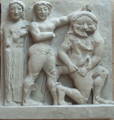
Athena (left) stands next to Perseus who decapitates a kneeling Medusa with Pegasus in her arms. 6th-c. BC stone relief, metope of Temple C from the ancient Greek city of Selinus (modern Selinunte), Sicily, Italy (the photo is of a cast from the original, in the cast collection of the Museum of Classical Archeology, Cambridge, England).
Medusa’s fate
It seems that the three Gorgon sisters were keeping their distance from the human world, but unfortunately for them, Perseus was ordered to find and kill Medusa and bring back her head to prove his feat. King Polydektes of Seriphos set this quest, in the hope that the hero would die trying, so that the king would be free to marry Perseus’ mother, Danae. Unfortunately for the king, Perseus was also the son of Zeus and he was successful in his quest, largely thanks to divine assistance that included the flying sandals of Hermes, the invisibility cap of Hades, a special sickle to decapitate Medusa, and a pouch to contain her deadly head. Upon his return to Seriphos, Perseus used Medusa’s head to petrify Polydektes, who was thus killed by the creature he had ordered dead.

Perseus runs with Medusa’s head inside his kibisis (speciala pouch), still holding the sickle with which he decapitated her. Behind Medusa’s headless body, Athena accompanies Perseus. Red-figured hydria of around 460 BC, British Museum, London, England.
Because Perseus was asked to return with proof of his victory, Medusa had the misfortune of being abused even after death, since her head was taken from place to place, to be used as a weapon. This was a rather cruel fate in the context of ancient Greek warrior culture, in which the mistreatment of a dead enemy’s body was considered sacrilegious. Unfortunately, as a female monster Medusa might have been considered akin to an animal, and that could have been one reason for which the trophy-like treatment of her head was not considered inappropriate. On his way back to Seriphos, Perseus used Medusa’s head to petrify another sea monster and save from death the beautiful Ethiopian princess Andromeda, whom he then married.

Perseus stands in front of Athena who holds and contemplates Medusa’s cut head (also reflected upside-down on her shield). Red-figured krater (for mixing wine and water), around 400-385 BC, Museum of Fine Arts, Boston.
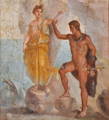
Perseus, holding Medusa’s head in his left hand, liberates Andromeda, while the sea monster sent to devour her is petrified behind her. 1st-c. BC wall painting from Pompeii, Naples Archeological Museum, Italy.
Medusa in art
Ancient Greek depictions of Medusa from the Archaic period (6th centuries BC) show her with a wide open mouth exposing sharp teeth and fangs and a prominent tongue, all meant to emphasize her aggressive and dangerous nature. Her big eyes stare daringly straight at the viewer (unlike what “proper” Greek women should do). Her head is surrounded by snakes. Often she even has a beard, which as a masculine trait was possibly meant to make her even more threatening. Her body is often shown in a pinwheel pose, with arms and knees bend, to suggest she is running or flying in vigorous movement, with impressive muscular legs exposed (all inappropriate features for demure Greek women). Wings that spring from her ankles and back visualize her hybrid nature, power, and speed. The above qualities are also reflected in the name Gorgo: in ancient Greek, the adjective gorgos meant terrible and fierce but also vigorous and rapid. The latter is the meaning the word gorgos retains in modern Greek (fast, speedy).

Medusa’s head (Gorgoneion), on a red-figure hydria of around 490 BC. British Museum, London.

Medusa’s head (Gorgoneion) is depicted bearded on this black-figured ceramic stand of around 570 BC. Metropolitan Museum of Art, New York.
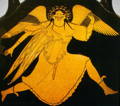
Medusa flying in a pin-wheel pose, red figured amphora of around 490 BC (with Perseus running on the other side). Staatliche Antikensamlungent (State Atiquitities Collections), Munich, Germany.
By the 4th century BC, Medusa’s severed head, the Gorgoneion, was no longer represented with monstrous features but as a beautiful and melancholic or anguished female face framed by rich curly hair that included snakes and wings. This is the version of Medusa that was popular in later art and is reflected in our jewelry. Scholars assume this transformation was inspired by the aesthetic values of 5th-c. classical art. Whatever the reason, the depiction of Medusa as a beautiful woman could have also made her a visual warning against the presumably destructive power of female beauty that should be tamed and controlled by men.
Interestingly, by the 2nd c. AC, Pseudo-Apollodoros claimed that according to some sources it was Athena who demanded Medusa’s death as punishment for her audacity to compare her beauty with that of the goddess.

Gold Gorgoneion from a royal Macedonian tomb of Aigai (northen Greece) that many scholars identify as that of Philip II, father of Alexander the great. Second half of the 4th c. BC, Vergina, Greece.

Marble Gorgoneion relief from the sculptural decoration of the Hellenistic Greek temple of Apollo at Didyma, Asia Minor (present day Turkey).
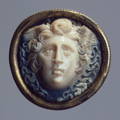
Roman cameo with Gorgoneion, 2nd-3rd c. AC, State Hermitage Museum, Saint Petersburg, Russia.
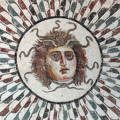
Roman bath mosaic floor with Gorgoneion, 2nd c. AC. Museum of Sousse, Tunisia.
A Roman retelling of Medusa’s story
Particularly disturbing patriarchal values are promoted by the version of Medusa’s myth penned by the Roman poet Ovid (1st c. BC-1st c. AC). In his Metamorphoses, he states that Medusa was a beautiful priestess of Minerva (Athena), and was raped inside the goddess’ temple by the sea god Neptune (Poseidon). Angry at the violation of her temple rather than her priestess, Minerva did not take up the matter with her divine uncle but instead punished Medusa by turning her into the hideous monster Perseus was later dispatched to kill. This storyline (in tune with many other literary sources from the Greco-Roman world that explored the fate of beautiful women) implies that the causes of female rape are not the lust and entitled mentality of the aggressor but the beauty and sexual appeal of the victim who is further mistreated as a survivor by being punished for “provoking” her misfortune.
In Medusa’s case, the imposition of a cruel punishment by another female character further reinforces the patriarchal ideology of that time. (In Greco-Roman mythology, Minerva/Athena was a manly goddess who sided with male authority, helped male heroes, was often cruel to women, and on the whole was a strong advocate of patriarchy.)

Bronze statue of Perseus with the head of Medusa by Benvenutto Cellini, 1545-54, Loggia dei Lanzi, Piazza della Signoria, Florence, Italy.
Ovid’s version of Medusa’s story was well-known during the Italian Renaissance. One of the most famous representations of the myth, Benvenuto Cellini’s bronze statue of Perseus triumphant over Medusa, created for the Medici in 16th c. Florence, is a chilling visualization of the patriarchal values of that time. Cellini did not simply depict Perseus in the heroic nudity reserved for male figures in Greco-Roman art. He also showed him stepping over the mangled body of a disheveled Medusa whose own nakedness is a sign of female vulnerability and sexualization and embodies her defeat in a manner that also alludes to rape (not just by Poseidon but by Perseus himself). It is no wonder that in our times a modern statue that reverses the myth and presents Medusa holding the sword and head of Perseus has become a symbol of the #MeToo movement. In this creation, Medusa is presented entirely naked, in the costume of ancient Greek male heroes. Her sad but determined expression evokes both her trauma and her fortitude. This version of the myth focuses on the suffering and resilience of female survivors rather than the triumph of a male warrior.
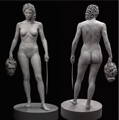
Statue of Medusa with the head of Perseus, by Argentinian-Italian artist Luciano Garbati, originally created in clay in 2008, later cast in Bronze by Vanessa Solomon of Carbon Sculpt Studios in Red Hook, Brooklyn, New York, and Laran Bronze Foundry in Philadelphia.
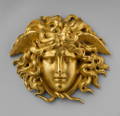
French gilt bronze furniture fixture with Gorgoneion. Late 18th-early 19th c., Metropolitan Museum of Art, New York.
Looking back at depictions of Medusa from the past, we might wonder how different members of society perceived this mythical character, especially when they encountered her head as a protective device on a wide range of objects and spaces. For example, Medusa’s beautiful face was often depicted with distinct dignity and gravitas on European cameo jewelry of the 19th century. Would at least some of the wearers and viewers of these objects perceive Medusa as a tragic heroine whose story could trigger meaningful reflections, not necessarily aligned with the patriarchal values of their time? What meanings would you attribute to your powerful Medusa jewelry from our collection?
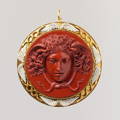
19th-c. jasper cameo with Gorgoneion, sculpted by Benedetto Pistrucci around 1840-50 and set in gold by Carlo Giuliano around 1860 (both Italian, active in England). Created for London dentist Samuel Cartwright. Metropolitan Museum of Art, New York.

Medusa
Italian, Rome
ca. 1860–70
Attributed to Luigi Saulini
Medium: Hardstone/Shell on Onyx
On view at The Met Fifth Avenue in Gallery 556
Medusa at Athena Gaia
Maria Evangelatou is a Professor of Mediterranean Studies, Department of History of Art and Visual Culture, University of California Santa Cruz.
Our gratitude to Maria for her research and contributions to this page.
